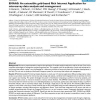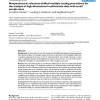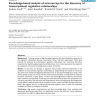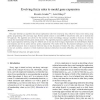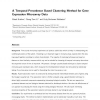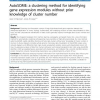BMCBI
2008
14 years 7 months ago
2008
Background: Microarray experimentation requires the application of complex analysis methods as well as the use of non-trivial computer technologies to manage the resultant large d...
BMCBI
2007
14 years 7 months ago
2007
Background: The identification of transcription factors (TFs) associated with a biological process is fundamental to understanding its regulatory mechanisms. From microarray data,...
BMCBI
2008
14 years 7 months ago
2008
Background: In many research areas it is necessary to find differences between treatment groups with several variables. For example, studies of microarray data seek to find a sign...
BMCBI
2010
14 years 7 months ago
2010
Background: The large amount of high-throughput genomic data has facilitated the discovery of the regulatory relationships between transcription factors and their target genes. Wh...
BIOSYSTEMS
2007
14 years 7 months ago
2007
This paper develops an algorithm that extracts explanatory rules from microarray data, which we treat as time series, using genetic programming (GP) and fuzzy logic. Reverse polis...
BMCBI
2010
14 years 7 months ago
2010
Background: Microarray technology is a high-throughput method for measuring the expression levels of thousand of genes simultaneously. The observed intensities combine a non-speci...
BMCBI
2010
14 years 7 months ago
2010
Background: The evolution of high throughput technologies that measure gene expression levels has created a data base for inferring GRNs (a process also known as reverse engineeri...
BMCBI
2010
14 years 7 months ago
2010
Background: Time-course microarray experiments can produce useful data which can help in understanding the underlying dynamics of the system. Clustering is an important stage in m...
BMCBI
2010
14 years 7 months ago
2010
Background: Clustering the information content of large high-dimensional gene expression datasets has widespread application in "omics" biology. Unfortunately, the under...
BIOINFORMATICS
2007
14 years 7 months ago
2007
Page 1 of 2Exploiting sample variability to enhance multivariate analysis of microarray data -- Möller-Le... http://bioinformatics.oxfordjournals.org/cgi/content/abstract/23/20/2...
